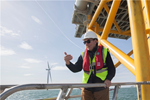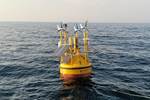ATLANTIS program develops 12-MW floating offshore wind turbine concept
Part of a two-year DOE-funded project, partners including GE and Glosten investigate lighter-weight, more economically competitive designs for offshore wind.

ATLANTIS (Aerodynamic Turbines Lighter and Afloat with Nautical Technologies and Integrated Servo-control) is a program begun in August 2019 by the U.S. Department of Energy’s (DOE) Advanced Research Projects Agency-Energy (ARPA-E). The two-year program includes 12 projects (including a prototype for a vertical-axis turbine design by the University of Texas), all aiming to advance floating offshore wind turbine (FOWT) technology.
On May 24, GE Research (Niskayuna, N.Y., U.S.) unveiled a design concept for the program’s 12-megawatt (MW) FOWT, the goal of which is to decrease levelized cost of energy (LCOE) by reducing the mass of the floating platform and integrating the control systems. Funded by a $4 million ARPA-E grant, the new design is said to reduce mass by 35% in the tower and platform compared to previous designs.
GE contributed the 12-MW turbine, which is supported by a GE-developed advanced controls system, and a tension leg platform as the foundation, called PelaStar, developed by marine design and consulting firm Glosten (Seattle, Wash., U.S.). According to GE, the platform design and a co-designed turbine controls system are expected to significantly reduce the levelized cost of energy (LCOE) of electricity generated with the turbine.
“Through our ATLANTIS project with ARPA-E, we will be concurrently designing the controls system with the design of the floating structure itself to advance floating offshore wind energy toward becoming a future commercially viable solution,” says Rogier Blom, senior principal engineer in model-based controls at GE Research, and the project’s principal investigator.
“Today’s fixed-bottom [offshore] wind turbines are limited to depths of 60 meters or less. With floating turbines, we would be able to dramatically expand the reaches of offshore wind power to areas with water depths of 60 meters or greater,” Blom adds.
Related Content
-
Composites end markets: Energy (2024)
Composites are used widely in oil/gas, wind and other renewable energy applications. Despite market challenges, growth potential and innovation for composites continue.
-
Composites end markets: Batteries and fuel cells (2024)
As the number of battery and fuel cell electric vehicles (EVs) grows, so do the opportunities for composites in battery enclosures and components for fuel cells.
-
Drag-based wind turbine design for higher energy capture
Claiming significantly higher power generation capacity than traditional blades, Xenecore aims to scale up its current monocoque, fan-shaped wind blades, made via compression molded carbon fiber/epoxy with I-beam ribs and microsphere structural foam.

.jpg;width=70;height=70;mode=crop)













